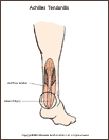
Achilles Tendon Injury
What is an Achilles tendon injury?
The Achilles tendon is a band of tissue that connects the heel bone to the calf muscle of the leg. Injury to the tendon may cause it to become inflamed or torn.
Achilles tendonitis is the term used when the tendon is inflamed. The inflammation causes pain at the back of your leg near the heel. A tear of the tendon is called a rupture. It also causes pain near your heel.
How does it occur?
Achilles tendonitis can be caused by:
- overuse of the Achilles tendon
- tight calf muscles
- tight Achilles tendons
- lots of uphill running
- increasing the amount or intensity of sports training, sometimes along with switching to racing flats, which are racing shoes with less heel lift
- over-pronation, a problem where your feet roll inward and flatten out more than normal when you walk or run
- wearing high heels at work and then switching to lower-heeled shoes for exercise.
An Achilles tendon may tear during sudden activity. For example the tendon might tear when you jump or start sprinting.
What are the symptoms?
Achilles tendonitis causes pain and may cause swelling over the Achilles tendon. The tendon is tender and may be swollen. You will have pain when you rise up on your toes and pain when you stretch the tendon. The range of motion of your ankle may be limited.
When the tendon tears or ruptures, you may feel a pop. If there is a complete tear, you will be unable to lift your heel off the ground or point your toes.
How is it diagnosed?
Your health care provider will examine your leg, looking for tenderness and swelling. Your provider will watch your feet when you walk or run to see if you over-pronate.
How is it treated?
- Put ice packs on the Achilles tendon for 20 to 30 minutes every 3 to 4 hours for the first 2 or 3 days or until the pain goes away.
- Raise your lower leg on a pillow when you are lying down.
- Take anti-inflammatory medication as prescribed by your health care provider.
- If your health care provider prescribes a heel lift insert for your shoe, wear it at least until your tendon heals and possibly longer. The lift prevents extra stretching of your Achilles tendon.
- While you are recovering from your injury, change your sport or activity to one that does not make your condition worse. For example, you may need to swim instead of run.
- Do any exercises your health care provider gives you to stretch and strengthen your Achilles tendon.
- If you over-pronate, your health care provider may prescribe custom-made shoe inserts, called orthotics, which help keep your foot stable.
- In some severe cases of Achilles tendonitis, your foot may be put in a cast for several weeks.
- A tear of the tendon may require surgery. Or your foot may be put in a cast for 6 to 10 weeks.
When can I return to my sport or activity?
The goal of rehabilitation is to return you to your sport or activity as soon as is safely possible. If you return too soon you may worsen your injury, which could lead to permanent damage. Everyone recovers from injury at a different rate. Return to your activity is determined by how soon your Achilles tendon area recovers, not by how many days or weeks it has been since your injury occurred. In general, the longer you have symptoms before you start treatment, the longer it will take to get better.
You may safely return to your sport or activity when, starting from the top of the list and progressing to the end, each of the following is true:
- You have full range of motion in the injured leg compared to the uninjured leg.
- You have full strength of the injured leg compared to the uninjured leg.
- You can jog straight ahead without pain or limping.
- You can sprint straight ahead without pain or limping.
- You can do 45-degree cuts, first at half-speed, then at full-speed.
- You can do 20-yard figures-of-eight, first at half-speed, then at full-speed.
- You can do 90-degree cuts, first at half-speed, then at full-speed.
- You can do 10-yard figures-of-eight, first at half-speed, then at full-speed.
- You can jump on both legs without pain and you can jump on the injured leg without pain.
How can I prevent Achilles tendonitis?
The best way to prevent Achilles tendon injury is to stretch your calf muscles and Achilles tendons before exercise. If you have tight Achilles tendons or calf muscles, stretch them twice a day whether or not you are doing any sports activities that day.
If you have a tendency to get Achilles tendonitis, avoid running uphill a lot.

